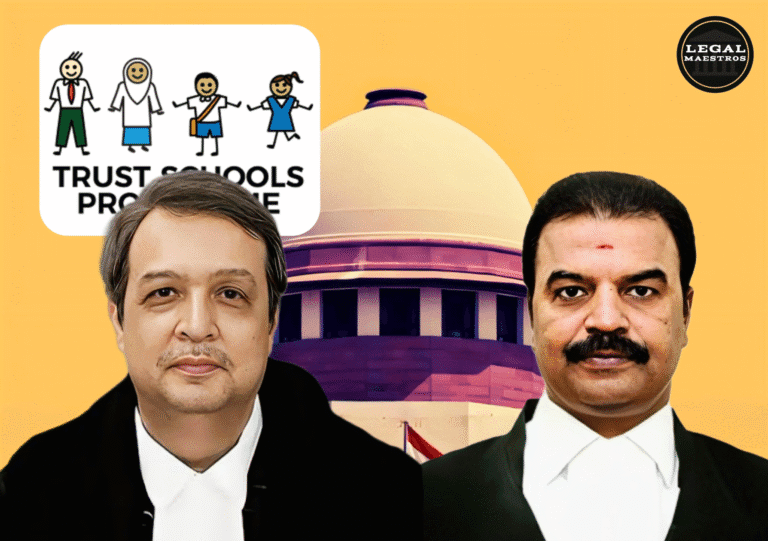
supreme court reprimands haryana chief secretary: how failure to curb illegal road construction in forests
Introduction
The Chief Secretary of Haryana was given a severe rebuke by the Supreme Court of India on June 5, 2025, for his failure to take prompt action against the construction of an illegal road that ran through a restricted forest region.
The reprimand was delivered in the form of a stern reprimand. Justice Augustine George Masih and the Chief Justice headed the bench, which voiced their displeasure of the senior administration of the state for their suspected involvement in a conspiracy with forest mafias and local officials.
The bench was chaired by Justice Augustine George Masih. As a result of this verdict, the judiciary is becoming increasingly dissatisfied with the bureaucratic delays that occur in matters relating to the management of protected forests and the protection of the environment.
For any queries or to publish an article or post or advertisement on our platform, do call at +91 6377460764 or email us at contact@legalmaestros.com.
Background of the Dispute
The disagreement was initially brought to light when local residents and environmental activists submitted an application stating that a wide road had been excavated through a portion of forest land in the Nuh region, which made it easier for illegal mining operations to take place.
This was the initial event that brought the conflict to light. According to the petitioners, the road passed through forestland that had not been disturbed for more than half a century.
This was the allegation that was made throughout the petition. The Supreme Court had previously requested that the Central Empowered Committee (CEC) undertake an inquiry and produce a report on the situation on the ground. This was due to the nature of the allegations that were being made.
For any queries or to publish an article or post or advertisement on our platform, do call at +91 6377460764 or email us at contact@legalmaestros.com.
For More Updates & Regular notes, Join Our WhatsApp group (https://chat.whatsapp.com/DkucckgAEJbCtXwXr2yIt0) and Telegram Group ( https://t.me/legalmaestroeducators )
CEC Investigation and Reports
The CEC presented a complete study in April 2025, which indicated that the road had, in fact, been constructed without the appropriate legal license. This information was included in the report.
In accordance with the findings of the inquiry, there was a plot that involved the Sarpanch of the village, officers from the tax department, and officials from the local police department.
For any queries or to publish an article or post or advertisement on our platform, do call at +91 6377460764 or email us at contact@legalmaestros.com.
It looked as though each of these folks had chosen to ignore the progress that was being made in the forest. In its conclusions, the CEC painted a picture of systematic negligence and drew attention to the removal of portions of hillocks, which caused concern over the long-term damage that would be caused to the environment.
Affidavit of Haryana Chief Secretary
In response to the report that was presented by the CEC on May 15, 2025, the Chief Secretary of Haryana submitted an affidavit that provided specifics of the state’s response. A pattern of transferring responsibility was revealed by the affidavit, rather than presenting proof of decisive acts being taken.
Despite the fact that the Chief Secretary indicated that he had acknowledged that he had received the notification from the CEC, he also stated that neither he nor his representatives had attended the hearings that were required.
For any queries or to publish an article or post or advertisement on our platform, do call at +91 6377460764 or email us at contact@legalmaestros.com.
According to him, he had issued notices to other high officials; nevertheless, he did not provide an acceptable reason for their absence, nor did he provide evidence of any disciplinary action taken against individuals who had defied the guidelines. He stated that he had sent alerts to other high authorities.
Supreme Court’s Observations on Laxity
Having expressed its extreme unhappiness with the “utmost laxity” demonstrated by the state administration, the Supreme Court has made its thoughts known.
The government of Haryana remained dormant until the involvement of the CEC necessitated a delayed response, despite the fact that it had received express directions from the highest court.
For any queries or to publish an article or post or advertisement on our platform, do call at +91 6377460764 or email us at contact@legalmaestros.com.
In the report, this was emphasized once again. It was pointed out by the bench that the Chief Secretary could not evade accountability by delegating it to lower-ranking officers or blaming them for it.
Therefore, the Chief Secretary could not avoid accountability. Justice Masih indicated in his remarks that the Chief Secretary, in his function as the administrative head of all state agencies, carried the ultimate duty for ensuring that forest conservation regulations were adhered to. This task was his job to see that the rules were followed.
Collusion with Forest Mafia
When it comes to the responsibility that forest mafias had, the decision that was handed down by the court did not pull any punches.
For any queries or to publish an article or post or advertisement on our platform, do call at +91 6377460764 or email us at contact@legalmaestros.com.
It was brought to light that persons who were engaged in illegal mining had benefited from the construction of the road, and that state staff appeared to have participated with these acts or at the very least allowed them to continue unchecked.
This information was brought to light as a result of the fact that it was brought to light. For the purpose of preserving India’s diminishing woods, the Supreme Court of India issued a warning that coalitions between administration officials and criminal elements contribute to the erosion of public confidence and undermine the rule of law. This is because such coalitions undermine the rule of law.
Directions to the Haryana Government
The Supreme Court issued an instruction to the Chief Secretary, asking him to initiate disciplinary procedures against all of the officers who were engaged in the affidavit and the CEC report.
For any queries or to publish an article or post or advertisement on our platform, do call at +91 6377460764 or email us at contact@legalmaestros.com.
This directive was made without any ambiguity. In order to fulfill its obligation, the bench was needed to prepare a comprehensive progress report by the 15th of July, 2025.
It was the purpose of the report to provide an explanation of the actions that were taken against the Sarpanch, officials from the revenue department, police officers, and any other staff members who had made errors.
In the event that it did not take any further action, the Court issued a warning that it would be compelled to investigate the prospect of employing its contempt powers and other appropriate remedies against the senior administrators of the state.
For any queries or to publish an article or post or advertisement on our platform, do call at +91 6377460764 or email us at contact@legalmaestros.com.
Reminder of Earlier Judgments
Furthermore, the decision of the Supreme Court recalled two earlier rulings that were handed out on May 15 and May 22, 2025. These court decisions were handed down.
As a result of such decisions, the Supreme Court mandated that state governments hand over to the forest authority management of reserved forest land that had been improperly retained by tax departments.
The court made the comment that the current situation with the construction of roads without authority would not have emerged if Haryana had complied with their orders. This reminder served to underline the commitment of the judicial system to ensuring that forest laws are enforced in a manner that is consistent throughout all states.
For any queries or to publish an article or post or advertisement on our platform, do call at +91 6377460764 or email us at contact@legalmaestros.com.
Implications for Forest Conservation
In the context of environmental governance, the intervention of the Supreme Court in the Nuh forest dispute is considered by legal scholars to be a significant exercise of judicial power.
By holding the Chief Secretary personally accountable for their acts, the Court has communicated that bureaucratic ineptitude will no longer be tolerated when ecological integrity is at stake.
This message was delivered by the Court. Observers believe that this decision will lead to a more severe monitoring of government actions related forest conservation and will deter future engagement with illicit resource extraction syndicates. This is something that observers think will ultimately result in.
For any queries or to publish an article or post or advertisement on our platform, do call at +91 6377460764 or email us at contact@legalmaestros.com.
Conclusion
The fact that the Supreme Court of India has given strong directives to the Chief Secretary of Haryana comes at a crucial juncture in the development of environmental law in India.
As a result of this verdict, swift administrative accountability is required, and the commitment of the court system to the conservation of forest ecosystems is reaffirmed.
The deadline of July is getting fast, and all eyes will be on the government of Haryana to assess whether or not it fulfills the decisions of the Court in both the text and the spirit of the law.
For any queries or to publish an article or post or advertisement on our platform, do call at +91 6377460764 or email us at contact@legalmaestros.com.
Should this not be carried out, it may lead to extra legal repercussions as well as a more comprehensive inquiry of the actions taken by the state in relation to environmental concerns.






![Research Assistantship @ Sahibnoor Singh Sindhu, [Remote; Stipend of Rs. 7.5k; Dec 2025 & Jan 2026]: Apply by Nov 14, 2025!](https://legalmaestros.com/wp-content/uploads/2025/11/Gemini_Generated_Image_s0k4u6s0k4u6s0k4-768x707.png)
![Karanjawala & Co Hiring Freshers for Legal Counsel [Immediate Joining; Full Time Position in Delhi]: Apply Now!](https://legalmaestros.com/wp-content/uploads/2025/11/Gemini_Generated_Image_52f8mg52f8mg52f8-768x711.png)